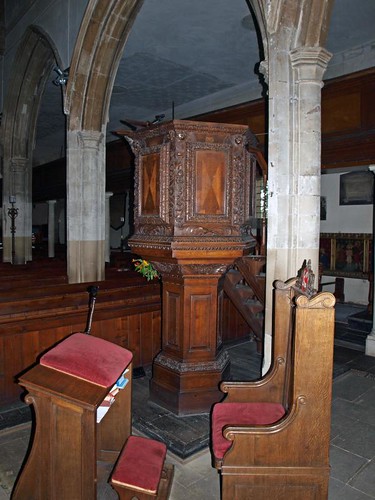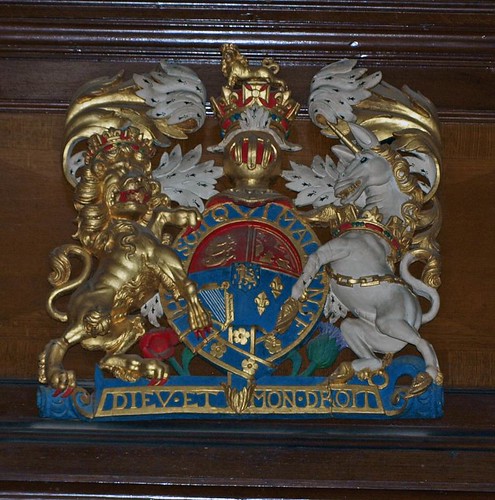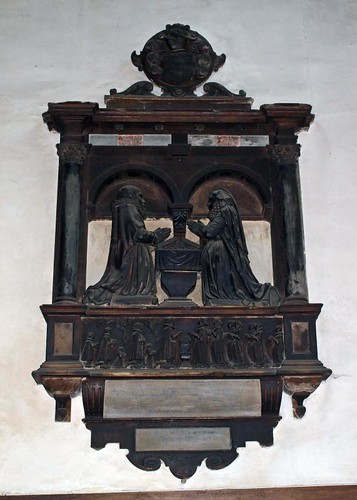ST PETER, North Hill. Essentially C18. Square red brick W tower of 1758. The upper part has white brick quoins and white brick battlements. To the street on a coarse bracket a clock. The aisle windows all arched, of c. 1700. White brick battlements. Inside, a few reminders of the medieval church; the arcades with piers with demi-columns to the aisle arches but a slim demi-polygonal shaft to the nave: C15. N and S galleries on Tuscan columns behind the arcades. Below the N Vestry a BONE-HOLE of c. 1520 with a brick vault with single-chamfered arches and ribs. - PULPIT. Fine piece of c. 1700 with richly moulded frames of the panels and garlands of fruit down the angles; cherubs’ heads at the top of these. - Heavy Neo-Gothic FONT, 1859 by C. F. Hayward. - COMMUNION RAIL with twisted balusters, used for the tower staircase. - DOOR in S doorway with large iron scrolls, late CI3. - PLATE. Paten on foot of 1698. - MONUMENTS. A number of rectangular plates with kneeling figures and inscriptions, ranging from 1509 to 1610. - Martin Basill d. 1623 and wife, with the usual kneeling figures, quite large; the figures set against a blank arch; columns l. and r. - George Sayer d. 1577 and wives, smaller and broader, also with kneeling figures, but with three columns and a straight entablature.
St Peter’s church has a fine door which opened for the congregation in the 14th century and has still its old lockplate and the ironwork a medieval craftsman made for it - a precious possession suggesting the work of Thomas of Leighton Buzzard, who made the grille which protects the lovely tomb of Queen Eleanor in the Confessor’s Chapel in Westminster Abbey. There is also a charming vestry door with its old ironwork, and under the vestry is a small vaulted chamber probably used as a charnel house. The fine oak pulpit was carved in the 18th century; near it in the floor is the stone of Sir William Campion, who was killed in the siege during the Civil War. The modern nave has 15th century arches and a group of monuments of the two centuries after that. Martin Basill kneels with his wife and 13 children on a marble tomb; George Sayer and his two wives are with their seven children, all elegantly chiselled and looking delightful in their ruffs. There are about 30 portraits in brass: William Brown with his wife and seven children; Agnes Leach with two husbands and nine children (1553); John Sayer of 1509 in an alderman’s gown, his wife in her widow’s veil with five children; another John Sayer kneeling at a desk; and Richard Sayer of 1610 with his two wives and two children in a quaint group. Over Richard Sayer’s brass is an oak memorial to a Richard of the family which tells us that he was driven by persecution to seek refuge among the pilgrims in Holland, and went to America and died there in 1676. His son came here and died here, and this memorial was put up by his family in 1687.
Simon K -
Open. The tower and the interior date from the 18th century. It looks
beautiful on its site at the top of North Hill, but what a gloomy, sad
interior this is! Entirely restored late 18th Century. Galleries run
down both aisles, and anything of medieval interest has been removed.
If I had to worship in this church every Sunday I would think that God
was a very dry, dusty fellow.
Simon K -
Colchester is unusual, and perhaps unique in England, because for a
town of 150,000+ people it has no large central church. There were
nine small medieval parishes, each with its own small church, but none
as big as Ipswich's St Mary le Tower, or Norwich's St Peter Mancroft,
or Cambridge's St Mary the Great. They suffered two depredations that
churches nowhere else in England had to suffer - most were ruined
during the 1648 Seige of Colchester (being the only fortified
buildings in town, the Royalists holed up in them and they were
attacked by the Parliamentarians) and then the earthquake of 1884,
after which two of them were demolished. One of the survivors, St
Peter, is now designated the 'town centre parish'.



No comments:
Post a Comment